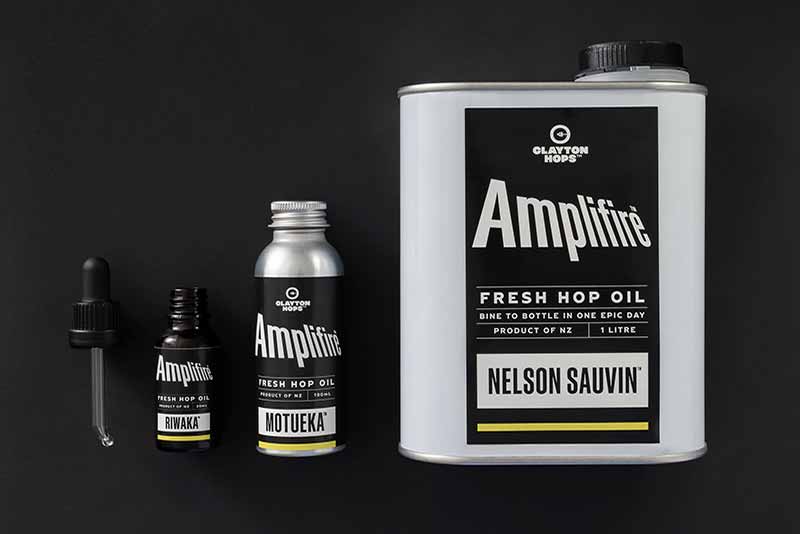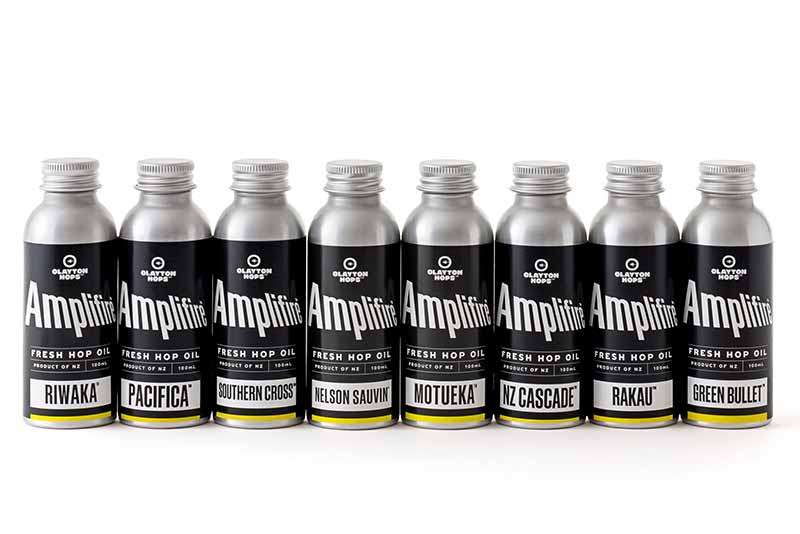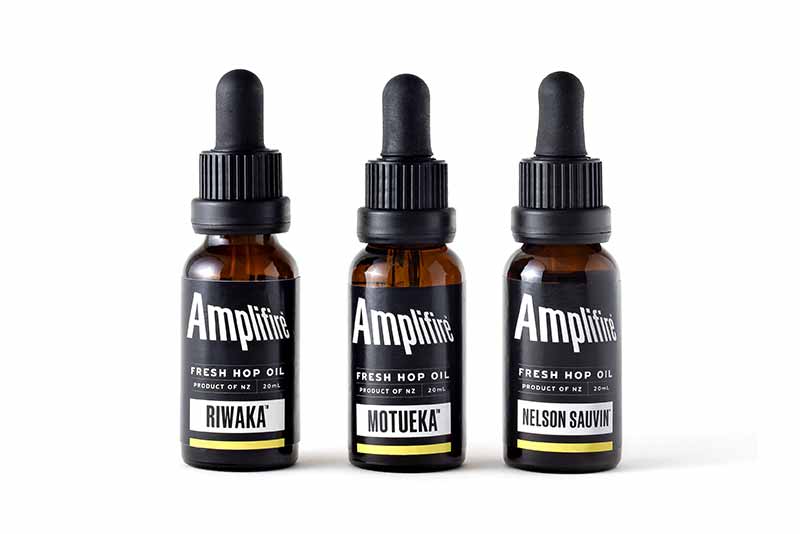
We’ve written ad nauseam about improving yield efficiency to help the bottom line. Companies globally are creating a seemingly countless number of hop innovations to adhere to that need above, including Abstrax Quantum Series, John I. Haas’ HopHaze, Incognito®, SPECTRUM®, and FLEX®, Hopsteiner’s Salvo™, Freestyle Hops’ SubZero Hop Kief, and Yakima Chief Hops’ DynaBoost. Add Clayton Hops’ Amplifire™ Fresh Hop Oil to that growing list.
We chatted with Clayton Hops CEO Brian Clayton and Quality, Innovation, and Sales Manager Lauren Yap about the product’s R&D, benefits, cost-effectiveness, and how to best use it.
What We’ll Cover in This Piece:
Affordable, Industry-Leading Brewery Software
Clayton Hops Explains Amplifire Fresh Hop Oil and its R&D

Photography courtesy of Clayton Hops
According to the Clayton Hops product page, Amplifire Fresh Hop Oil is a water-soluble liquid dry hop or brite tank addition product. Clayton Hops plucks wet whole hops off the vine, runs them back to their in-house processing facility, and extracts the oil on the same day they were harvested without any drying or pelletizing.
Clayton says the idea of making the oil came around 2020 or 2021 when a “good customer” of Clayton Hops asked if they could produce the liquid hop.
“We had continued to make it in tiny amounts for two to three years and then commercialized it at the Master Brewers Conference in Seattle last year,” Clayton says. “That’s how it started. [Brewers at the conference] loved it.”
Clayton adds, “There’s been so much interest in the product. It’s been a great addition to the portfolio.”
Clayton has refined Amplifire Fresh Hop Oil over time.
“It’s been three years of making the product and getting feedback,” Clayton says. “Then bringing it in-house with a different beta process has got us a pretty good product.”
Clayton admits there was a learning curve when they brought it to their plant this year, but “we had a good feeling on how to do it, and the equipment is dialed in.”
Now Clayton Hops has streamlined the process so that they can harvest wet whole-cone hops and extract the oils within an eight-hour workday.
“A team is picking at the farm between 2 and 4 a.m., and we [have it back to our facility to] extract by 5 a.m., and have it out by 6 a.m., and continue processing all day,” says Yap. “It’s cool because it mimics the fresh-hop beer process.”
Yap joined Clayton Hops after Amplifire Fresh Hop Oil’s first two harvests, which took place in New Zealand from late February to late March. As a part of the R&D team, Yap often brews with Amplifire, looking for ways to refine it.
“We tackled the sensory consistencies and produced it ourselves to see how we can expand it to take it to the market,” Yap says. “We started experimenting with [harvesting] different varieties; and [having it] in-house, we got to collect as much data as possible.”
There were several hot-button issues they were aiming to address.
“A lot of R&D is making it water-soluble and making sure it was a true hop product,” Yap says. “Also, we were fine-tuning efficiencies, such as the time to get from the farm to the end product, and making sure it’s usable in all capacities.”
Clayton says that as a part of that efficiency testing, Yap travels to the farm to find the best day to pick the hops and do the extractions.
“We’re trying to choose the day of harvest that works well for oil,” says Clayton, who notes that they look for high oil content in the hops to determine whether they pick on any given day.
All the work culminated with Clayton Hops showcasing the Amplifire Fresh Hop Oil product at this year’s Craft Brewers Conference in Las Vegas, and the response was humbling.
“Interest there was off the charts,” Clayton says. “It’s been three or four years of trial and error, but now we have it under control.”
What Are the Benefits of Amplifire Fresh Hop Oil?

Photography courtesy of Clayton Hops
Yap says there are “massive benefits” to using the Amplifire Fresh Hop Oil, which gets dosed cold side to finished beer, either pre- or post-centrifuge.
“We’re not immune to downstream hop products in brewing,” Yap says. “Brewers definitely want more efficiencies in hop-bomb beers and getting cost savings. Amplifire is improving efficiencies, stability, cost, and storage space.”
Amplifire can be stored at ambient temperature, but Yap says it is best stored in a fridge, like hops.
She adds, “There are a lot of hop extracts in the market. Our advantage is that we are not kilning, the shipping cost is less, and we have a unique advantage in that our farm is on our back doorstep.”
Clayton says that they also work with bigger craft breweries that use the product with mainstream beers.
“It all comes back to brewing efficiencies,” Clayton says. “You yield more beer. That’s what this product allows them to do.”
And the carbon footprint is super low, too, he says.
“We use renewable energy to extract the oils,” Clayton says. “We’re looking to [test for] the carbon footprint now [and] expect it to be really low.”
Adds Yap, “There is an ease of dosing, too. It’s really great for brewers. It’s a pourable product, which makes it a lot easier.”
And the flavor and aroma brings a “real wow,” Clayton and Yap say.
“There is a massive increase in the flavor and aroma,” Yap says. “Brewers’ immediate response is it’s so punchy, super fresh, super juicy. It’s almost sensory overload.”
How Much Cost Savings Does Amplifire Fresh Hop Oil Bring?

Photography courtesy of Clayton Hops
An added benefit to using Amplifire Fresh Hop Oil is the cost savings, which Clayton says “can’t be missed.”
“Other extracts seem quite pricey,” Clayton says. “We can control everything from the farm to the processing, which [makes] our pricing competitive.”
According to Clayton, that enhances when you consider swapping out T-90 hop pellets for Amplifire Fresh Hop Oil.
“Beer losses will drop,” he says.
While Clayton is unsure of the quantifiable figure on price savings, he believes it’s considerable.
“When you do the math and check the price point, it’s an outstanding cost saver,” he says.
What Is the Dosage Rate of Amplifire Fresh Hop Oil?
Yap says that it is really up to the brewers to decide how to dose with Amplifire Fresh Hop Oil. But they have gotten some feedback.
“Brewers tell us that using 100 milliliters of Amplifire [Fresh Hop] Oil is the equivalent to 5 kilograms of T-90 pellets,” Yap says.
Clayton and Yap say that some brewers have swapped out pellets for the oil, others completely replace T-90s in the dry hop, and some pop it into the brite tank for extra top notes or complexity.
According to the product page, when dry-hopping in lighter beer styles, add 3 to 5ml per hectoliter, assuming a dry-hopping range of 0.5 to 5g per liter. Pale ales should have a dosage rate between 10 to 15ml per hectoliter for a dry-hopping range of 4 to 10g per liter. IPAs should be between 15 and 20ml per hectoliter with a dry-hopping range of 8 to 15g per liter, and hop water should be from 3 to 15ml per hectoliter.
The dosing should be used anywhere during the cold-side phase of the brewing process, whether dry hopping or into the brite tank, but Yap says it should be done pre-carbonation.
“We recommend rousing the beer. Don’t drop it in and call it a day,” Yap says. “We would recommend using it in a pre-carbonation and then carbonate.”
Because it’s water soluble, it’s pretty easy to get the correct dosage quickly.
“We say to shake the bottle, but otherwise, just pour it in,” Yap says.
What Style of Beer Works Best with Amplifire Fresh Hop Oil?

Photography courtesy of Clayton Hops
Yap says there is no limit to what beers you can make with Amplifire Fresh Hop Oil.
“It goes well in loads of beers,” Yap says. “Lots of brewers here in New Zealand are using it in core beers and dry hop lagers. Also, a New Zealand-style pilsner, which is dry hopped.”
Yap adds, “We recommend it from light lagers and kolschs to juicy IPA. I think there are places for it everywhere.”
And Clayton thinks it goes beyond beer.
“It even works well in hop waters,” he says. “As long as you use it in the right places.”



